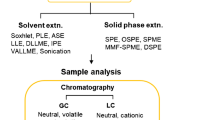Abstract
In this study, we report a 2,4-dinitrophenylhydrazine (DNPH) derivatization HPLC/UV method to quantify carbonyl compounds (CCs) either in electronic cigarette (EC) refill solutions or in vaped aerosols. Vaped aerosol samples were entrained in a 1 L atm min−1 ambient lab air stream and pulled through an impinger containing a DNPH solution for derivatization. The mass change tracking (MCT) approach was used to check mass balance. Refill solution samples were diluted (2, 4, and 10 times) in a DNPH/acetonitrile solution for derivatization. EC vaping samples were collected for 5, 10, or 15 puffs (2-s puff duration) with a 10-s interpuff interval. The DNPH derivatization method was used successfully for the estimation of both EC liquid CCs concentrations and vaping emission factors. The results for formaldehyde (FA), acetaldehyde (AA), and butyraldehyde (BA) were determined as 10.4 ± 3.10 μg mL−1 (27.6 ± 7.43 ng puff−1), 1.9 ± 0.83 μg mL−1 (4.4 ± 1.98 ng puff−1), and 4.4 ± 2.82 μg mL−1 (12.0 ± 7.43 ng puff−1), respectively.


Similar content being viewed by others
References
Bansal, V., & Kim, K.-H. (2016). Review on quantitation methods for hazardous pollutants released by e-cigarette (EC) smoking. TrAC Trends in Analytical Chemistry, 78, 120–133.
Bekki, K., Uchiyama, S., Ohta, K., Inaba, Y., Nakagome, H., & Kunugita, N. (2014). Carbonyl compounds generated from electronic cigarettes. International Journal of Environmental Research and Public Health, 11, 11192–11200.
Cho, Y.-H., & Shin, H.-S. (2015). Use of a gas-tight syringe sampling method for the determination of tobacco-specific nitrosamines in E-cigarette aerosols by liquid chromatography-tandem mass spectrometry. Analytical Methods, 7, 4472–4480.
Doll, R., Peto, R., Wheatley, K., Gray, R., & Sutherland, I. (1994). Mortality in relation to smoking: 40 years’ observations on male British doctors. British Medical Journal, 309, 901–911.
Doll, R., Peto, R., Boreham, J., & Sutherland, I. (2004). Mortality in relation to smoking: 50 years’ observations on male British doctors. British Medical Journal, 328, 1519–1528.
Etter, J. F., Zather, E., & Svensson, S. (2013). Analysis of refill liquids for electronic cigarettes. Addiction, 108, 1671–1679.
Farsalinos, K. E., & Le Houezec, J. (2015). Regulation in the face of uncertainty: the evidence on electronic nicotine delivery systems (e-cigarettes). Risk Management and Healthcare Policy, 8, 157.
Farsalinos, K. E., & Polosa, R. (2014). Safety evaluation and risk assessment of electronic cigarettes as tobacco cigarette substitutes: a systematic review. Therapeutic Advances in Drug Safety, 5(2), 67–86.
Geiss, O., Bianchi, I., Barahona, F., & Barrero-Moreno, J. (2015). Characterisation of mainstream and passive vapours emitted by selected electronic cigarettes. International Journal of Hygiene and Environmental Health, 218(1), 169–180.
Goniewicz, M. L., Knysak, J., Gawron, M., Kosmider, L., Sobczak, A., Kurek, J., Prokopowicz, A., Jablonska-Czapla, M., Rosik-Dulewska, C., & Havel, C. (2014). Levels of selected carcinogens and toxicants in vapour from electronic cigarettes. Tobacco Control, 23, 133–139.
Guthery, W. (2016). Emissions of toxic carbonyls in an electronic cigarette. Beiträge zur Tabakforschung International Contributions to Tobacco Research, 27(1), 30–37.
Han, S., Chen, H., Zhang, X., Liu, T., & Fu, Y. (2016). Levels of selected groups of compounds in refill solutions for electronic cigarettes. Nicotine & Tobacco Research, 18(5), 708–714.
International Organization for Standardization (ISO) 3308:2012 (2012). Routine analytical cigarette-smoking machine—Definitions and standard conditions.
Jo, S.-H., & Kim, K.-H. (2016). Development of a sampling method for carbonyl compounds released due to the use of electronic cigarettes and quantitation of their conversion from liquid to aerosol. Journal of Chromatography A, 1429, 369–373.
Kim, H.-J., & Shin, H.-S. (2013). Determination of tobacco-specific nitrosamines in replacement liquids of electronic cigarettes by liquid chromatography–tandem mass spectrometry. Journal of Chromatography A, 1291, 48–55.
Kim, K.-H. (2016). Mass change tracking approach as collection guidelines for aerosol and vapor samples released during e-cigarette smoking. Analytical Methods, 8, 2305–2311.
Kim, Y.-H., & Kim, K.-H. (2015). A novel method to quantify the emission and conversion of VOCs and their emission factor in the smoking of electronic cigarettes based on the mass change tracking (MCT) approach. Scientific Reports, 5, 16383.
Kosmider, L., Sobczak, A., Fik, M., Knysak, J., Zaciera, M., Kurek, J., & Goniewicz, M. L. (2014). Carbonyl compounds in electronic cigarette vapors: effects of nicotine solvent and battery output voltage. Nicotine & Tobacco Research, 16, 1319–1326.
Lee, S., Kimm, H., Yun, J. E., & Jee, S. H. (2011). Public health challenges of electronic cigarettes in South Korea. Journal of Preventive Medicine and Public Health, 44(6), 235–241.
Malhotra, J., Malvezzi, M., Negri, E., La Vecchia, C., Boffetta, P., (2016). Risk factors for lung cancer worldwide. European Respiratory Journal ERJ-00359.
Polosa, R., Knoke, J. D., Russo, C., Piccillo, G., Caponnetto, P., Sarvà, M., Proietti, L., & Al-Delaimy, W. K. (2008). Cigarette smoking is associated with a greater risk of incident asthma in allergic rhinitis. Journal of Allergy and Clinical Immunology, 121(6), 1428–1434.
Pope, C. A., Burnett, R. T., Turner, M. C., Cohen, A., Krewski, D., Jerrett, M., Gapstur, S. M., & Thun, M. J. (2011). Lung cancer and cardiovascular disease mortality associated with ambient air pollution and cigarette smoke: shape of the exposure-response relationships. Environmental Health Perspectives, 119(11), 1616–1621.
Protano, C., Di Milia, L., Orsi, G., & Vitali, M. (2015). Electronic cigarette: a threat or an opportunity for public health? State of the art and future perspectives. La Clinica Terapeutica, 166(1), 32–33.
Protano, C., Manigrasso, M., Avino, P., & Vitali, M. (2017). Second-hand smoke generated by combustion and electronic smoking devices used in real scenarios: ultrafine particle pollution and age-related dose assessment. Environment International, 107, 190–195.
Schripp, T., Markewitz, D., Uhde, E., & Salthammer, T. (2013). Does e-cigarette consumption cause passive vaping? Indoor Air, 23(1), 25–31.
Shin, H.-S. (2013). Review on toxic substances in the liquid and gas phases of electronic cigarettes. Korean Society of Environmental Health, 12, 483–491.
Shopland, D. R. (1995). Tobacco use and its contribution to early cancer mortality with a special emphasis on cigarette smoking. Environmental Health Perspectives, 103(8), 131–142.
Stampfli, M. R., & Anderson, G. P. (2009). How cigarette smoke skews immune responses to promote infection, lung disease and cancer. Nature Reviews Immunology, 9, 377–384.
Szulejko, J. E., & Kim, K.-H. (2015). Derivatization techniques for determination of carbonyls in air. Trends in Analytical Chemistry, 64, 29–41.
Uchiyama, S., Ohta, K., Inaba, Y., & Kunugita, N. (2013). Determination of carbonyl compounds generated from the e-cigarette using coupled silica cartridges impregnated with hydroquinone and 2,4-dinitrophenylhydrazine, followed by high-performance liquid chromatography. Analytical Sciences, 29, 1219–1222.
United States Department of Health and Human Services (USDHHS) (2004). The health consequences of smoking: a report of the surgeon general. Atlanta : USDHHS, Public Health Service, Centers for Disease Control and Prevention, National Center for Chronic Disease Prevention and Health romotion, Office on Smoking and Health.
Well, A. J. (1994). Passive smoking as a cause of heart disease. Journal of the American College of Cardiology, 24(2), 546–554.
World Health Organization (WHO) (2012). Standard operating procedure for intense smoking of cigarettes.
Funding
This research was supported by a grant (14182MFDS977) from the Ministry of Food and Drug Safety in 2017. This study was also supported by a National Research Foundation of Korea ((NRF) funded by the Ministry of Science, ICT & Future Planning (No. 2016R1E1A1A01940995).
Author information
Authors and Affiliations
Corresponding author
Rights and permissions
About this article
Cite this article
Lee, MH., Szulejko, J.E. & Kim, KH. Determination of carbonyl compounds in electronic cigarette refill solutions and aerosols through liquid-phase dinitrophenyl hydrazine derivatization. Environ Monit Assess 190, 200 (2018). https://doi.org/10.1007/s10661-018-6553-2
Received:
Accepted:
Published:
DOI: https://doi.org/10.1007/s10661-018-6553-2




